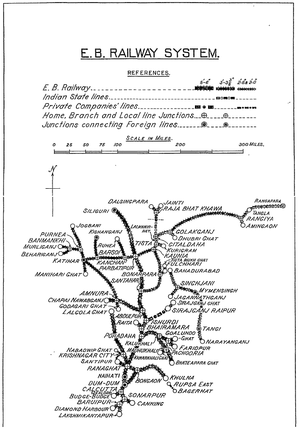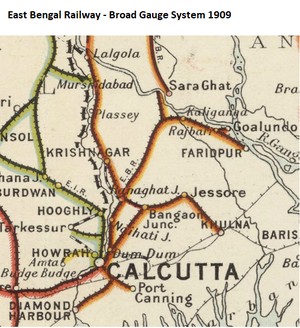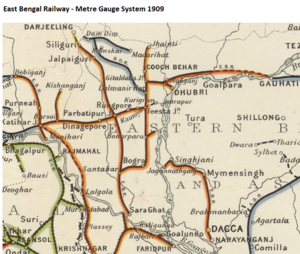Eastern Bengal Railway - Lines owned and worked
Eastern Bengal Railway - Lines owned and worked

- a sub-section of the Eastern Bengal Railway(EBR) page
- see also separate page Eastern Bengal Railway Bridges
EBR Railway Network
The Eastern Bengal Railway(EIR) owned and operated an extensive network of railways of broad gauge(BG), metre gauge(MG) and 2ft 6in/762mm narrow gauge(NG)
The EBR also managed, worked and maintained a number of lines on behalf of other parties.
The development of the EBR can be considered as three systems:-

EBR Broad Gauge System
The following is generally based on pages 42-43 of the ‘1918 Administration Report on Railways’ [1]
The broad gauge(BG) from the Calcutta terminus station at Sealdah via Dum Dum and Ranaghat to Poradaha opened in 1862 and extended in 1864 to Kushtia. The company had also acquired a steam vessel service operating between Kushtia and Dacca on the Ganges River (known in this region as the Padma River) [2]. In 1871 the line was extended from Poradaha to a new ferry terminal at Goalundo , about 45 miles east of Kushtai and reducing the river trip to Dacca. These railways became the start of the ‘EBR Eastern Division’.
In 1868 the Government of India took ownership of the BG Calcutta and South Eastern Railway and awarded the EBR the contract for working the line from Calcutta to Port Canning. This became, this became start of the the ‘EBR Southern Section’.
‘EBR Eastern Section’ - by 1874 the BG branch from Poradaha to Damukdia on the right bank of Padma River, opposite Sara Ghat had opened. Passengers crossed the river Padma by railway operated steamer ferry using the Sara Train Ferry. In 1874 this linked to the metre gauge(MG) Northern Bengal State Railway (NBSR) running northwards reaching Siliguri. By 1879 the journey north from Calcutta to Shiliguri became possible without a break. At Siliguri , in the foothills of the Himilayas, there was a connection with the Darjeeling-Himalayan Railway (which opened 1879-81) [3]
‘EBR Central Section’ - the EBR operated the Bengal Central Railway from the outset with two BG lines Ranaghat to Bangaon, opened in Oct 1882; and Dum Dum which reached Khulna (Khoolna) in 1884, via Bangaon (Bongong) and Jessore.
‘EBR Southern Section’- in 1883 was extended to reach Diamond Harbour.
‘EBR Eastern Section’ - in 1890 was extended further eastward to Faridpur and from 1905 northwards to reach Murshidabad and on to Lalgola Ghat in 1907. Two proposals for further extensions are given in the ‘Imperial Gazetteer’ :- the 1909 map shows a dotted line to extend the line northwards from Lagola to connect to the EBR metre gauge(MG) network at Katiawar
[4]
and the ‘Imperial Gazetteer’ states [5] “There is also a proposal to bridge the Bhagirathi River between Jiaganj and Murshidabad, and to connect the new line with the East Indian Railway system”.
Neither of these proposals were adopted.
Further minor branches had been constructed thereafter, giving by 1918 [1] a total BG network of 569 miles(915km) :-
- ‘EBR Eastern Section’ 371 miles(597km)
- ‘EBR Southern Section’ 70 miles(113km)
- ‘EBR Central Section’ 128 miles(206km)
By 1937 the BG line length increased to 846 miles(1361km) [6]:-
- ‘EBR Eastern Section’ 629 miles(1012km). The original ‘BG Main Line’ from Calcutta ran as far as Santahar where it interchanged to the ’Santahar-Silguri Extension’, a 145 mile(233km) metre gauge(MG) that had opened in 1877-78. This was converted to BG in stages from 1914 to 1926 to thus extending the ‘BG Main Line’
- ‘EBR Southern Section’ 92 miles(148km), with the added 23 miles(37km) ‘Lalshmikantapur Branch’, opened 1928
- ‘EBR Central Section’ 126 miles(203km) with only minor corrections from the 1918 Reportr
Lines worked by EBR and included in the ‘EBR BG System
In addition the BG Sara-Sirajgonj Railway 53 mile(85km) branch from the EBR mainline had been constructed and then worked by EBR as a part of the ‘EBR Eastern Section’

EBR Metre Gauge System
The following is generally based on pages 47-48 of the ‘1918 Administration Report on Railways’ [7]
The EBR metre gauge(MG) system originated by absorption of other railways
See separate pages for more information and references
Northern Bengal State Railway (NBSR) in 1877-78 opened the MG Santahar via Parvatipur(Parbatipur on map) to Jalpaguri line extending it northwards to Siliguri in 1878 and southwards to the Train Ferry at Sara Ghat in 1879. This completed the northern link. The NBSR had also by this date completed the line eastward from Parvatipur via Rangpur(Rungpore on map) to Kaunia(Kauniya on map). At Kaunia the line linked to the narrow gauge(NG) Kaunia-Dharlia State Tram/Railway. In 1887, to ensure better management the NBSR was transferred to the EBR, this became the start of the ‘EBR Metre Gauge’.
Dacca State Railway(DSR) also in 1887, was transferred to the EBR although this MG line was not connected to the EBR system. Later, in 1899, the EBR constructed the MG Mymensingh-Jamalpur-Jagannath Railway, owned by the Indian General Navigation and Railway Company. The two lines were linked and worked jointly by EBR.
Brahmaputra-Sultanpur Railway in 1899-1900 opened two MG lines which were worked by EBR. Santahar to Bonarpara, 51 miles(81km) and the Phulchari Branch Railway from Bonarpara to Phulchari, 8 miles(14km). In 1904 the EBR acquired these lines became the first part of the EBR ‘Santahar-Kaunia Loop Section’ when the system was extended to Kaunia in 1905
Gauhati Branch Railway in 1906 the EBR opened from Golakganj eastward and reached Armingoan by 1909; where it linked to EBR’s Amingaon-Pandu Train Ferry; crossing the Brahmaputra River to the Pandu Ghat-Gauhati Railway connecting to Assam-Bengal Railway(ABR) at Gauhati. This completed the ‘EBR Mainline MG’ of 328 miles(528km).
By 1918, with further construction of branches, the EBR network had a MG line length of 978 miles(1574km) [7]
By 1937 the MG line length had increased to 1039 miles(1672km) with the addition of several MG branch lines and the reduction of 145(miles(223km) converted from MG to extend the ‘Eastern Section - ‘BG Main Line’ mentioned above. [8]-

EBR Narrow Gauge System
The following is generally based on pages 49-52 of the ‘1918 Administration Report on Railways’ [9].
The EBR 2ft 6in/762mm narrow gauge(NG system originated by absorption of other railways
See separate pages for more information and references
Kaunia-Kurigram Railway had opened in 1882 as a 2ft 6in/762mm narrow gauge(NG) line running east wards from Kaunia, where it connected to the NBSR metre gauge(MG). Taken over by EBR in 1887 and in 1901 the section from Kaunia to Teesta was converted to MG becoming part of the 'EBR Metre Gauge'
Cooch Behar State Railway, 2ft 6in/762mm NG, from its junction with the EBR at Gitaldaha reached Cooch Behar in 1898, owned by the Princely Cooch Behar State and worked by the EBR. The line was extended northward to the border with British Territory in 1900 and to Jainti in the foothills of the Eastern Himalayas in 1901. In 1910 the entire line from Gitaldaha to Jainti line was converted to MG becoming the 'Jainti Branch' of the 'EBR Metre Gauge'
Khulna-Bagerhat Railway, 2ft 6in/762mm NG, 20 miles(32km) opened in 1918. Owned by a private company but worked by EBR. The line ran from Khulna Khulna was the end of the ‘EBR Central Section’ broad gauge(BG) mainline to Bagirhaut,
Alphabetical Listing of EBR lines and lines worked by EBR
See separate pages for more information and references
- Bengal Central Railway, BG line, opened 1882-84 and worked by EBR. Private company without guarantee; merged into EBR , 1905 becoming the start of the ‘EBR Central System’.
- Bengal Dooars Railway(BDR), MG line, opened 1893. Independent Company operation small MG network linking to the ‘EBR Metre Gauge’ ’Lalmanir Hat- Gitaldaha’ MG section, merged into EBR , 1941
- Brahmaputra-Sultanpur Railway, MG line, opened 1899 by a branch company but worked by EBR. Amalgamated into the EBR, 1904 together with Phulchari Branch Railway, to form the ‘Santahar-Kaunia Loop Railway’.
- Budge-Budge Branch Railway, BG branch line of ‘EBR Southern Section’, opened 1890.
- Calcutta and South Eastern Railway, BG line, opened 1862. Surrendered to GoI , 1868 and worked by EBR; merged into EBR, 1884 becoming the start of the ‘EBR Southern Section’.
- Canning Branch Railway, BG branch line of ‘EBR Southern Section’, opened 1862-63.
- Chitpur Branch Railway, BG branch line of ‘EBR Eastern Section’, opened 1873.
- Churni Extension Railway, BG short extension of ‘EBR Eastern Section’, opened 1902
- Cooch Behar State Railway, NG line, opened 1894-98. Princely State railway, joined to the Jainti Branch Railway, (British Section ), worked by EB, and finally bought by EBR c.1899 and converted to MG, 1910.
- Dacca State Railway, MG line, formerly Narayanganj-Dacca-Mymensingh State Railway, opened 1885 ; merged into EBR , 1887; becoming the EBR ‘Dacca Section Railway’.
- Dacca Section Railway, MG section of the of ‘EBR Metre Gauge’, transferred to EBR 1887 from ”Dacca State Railway’.
- Dalsingpara Branch Railway, BG branch line of the Jainti Branch of ‘EBR Eastern Section’, under construction in 1911, opened 1912 extended 1914.
- Dhubri Branch Railway, MG branch line of ‘EBR Assam Section Metre Gauge’, opened 1902
- Diamond Harbour Line Railway, BG link line opened 1862 by the Calcutta and South Eastern Railway; and worked by EBR; merged into EBR, 1884 becoming the start of the ‘EBR Southern Section’.
- Faridpur Branch Railway, BG branch of the Poradah Branch Railway of ‘EBR Eastern Section’, opened 1898-99.
- Gauhati Branch Railway, MG branch line of ‘EBR Assam Section Metre Gauge’, incorporating part of Kaunia-Dharlia State Tram/Railway , opened 1906, extended up to 1909.
- Goalundo Branch Railway, BG branch line of ‘EBR Eastern Section’, opened 1862; extended up to 1882.
- Godagari Ghat Branch Railway, MG branch line from the Kahihar Section of ‘EBR Metre Gauge’, opened 1909.
- Jainti Branch Railway, (British Section ), MG branch line of ‘EBR Metre Gauge’, converted to MG 1910. Originally NG, opened 1900-1 as a feeder through ‘British Territory’ to join with the ‘Cooch Behar State Railway’
- Jagannathganj Ghat Branch Railway, MG branch line of ‘EBR Metre Gauge’ of the Dacca Section Railway, formerly the Dacca State Railway, opened c.1887?
- Jogbani Branch Railway, MG branch line from the Kahihar Section of ‘EBR Metre Gauge’, opened 1887, extended 1909.
- Kankurgachi Chord Railway, BG short connecting line of ‘EBR Eastern Section’, opened 1907.
- Katihar Section Railway, MG section of ‘EBR Metre Gauge’, opened 1883 and extended 1889.
- Kaunia-Bonarpara Extension Railway, MG section of ‘EBR Metre Gauge’ as an extension to Santahar-Kaunia Loop Railway, opened 1905.
- Kaunia-Kurigram Railway, NG line, opened 1882 , taken over by EBR 1887, divided into two sections - the ’Kaunia-Teesta Section’ and the ’Teesta-Kurigram Railway’.
- Kaunia-Teesta Section Railway, originally a NG line and part of the ’ Kaunia-Kurigram Railway’, opened 1882, taken over by EBR 1887, the ’ Kaunia-Teesta Section’ converted to MG, 1901, to become part of the the 'EBR Metre Gauge' mainline. *Kaunia-Kurigram Railway.
- Kaunia-Dharlia State Tram/Railway, NG line, opened 1882 , alternative name see ’Kaunia-Kurigram Railway’.
- Khulna-Bagerhat Railway, NG line, opened 1918-19. Narrow gauge(NG) railway owned by private company. ; Constructed and worked by EBR, later converted to MG becming part of ‘EBR Metre Gauge’ system.
- Khulna Branch Railway, BG line, opened 1883-4 as a branch of Bengal Central Railway; until merger in 1905 when becoming a branch line of the ‘EBR Eastern Section’.
- Kishanganj Branch Railway, MG branch line of the Kahihar Section of ‘EBR Metre Gauge’, opened 1892.
- Kosi Branch Railway, MG branch line of ‘EBR Metre Gauge’, opened 1887, extended to 1909
- Krishnager-Nabadwip Light Railway , NG line part of the Santipur-Nabadwip Light Railway
- Kurigram Branch Railway, NG line, alternative name see ‘Teesta-Kurigram Branch Railway’
- Kushtia Loop Railway, BG branch line of ‘EBR Eastern Section’, opened 1864; extended 1881
- Lalgola Ghat Branch Railway,BG branch line of ‘EBR Eastern Section’opened 1905 as the Murshidabad Branch Railway, extended 1907 to ’Lalgola Ghat’
- Lalmanir Hat- Gitaldaha Railway, MG section of the ‘EBR Metre Gauge’ mainline , opened 1901-02 providing link between Bengal Dooars Railway and Cooch Behar State Railway.
- Manihari Branch Railway, MG section of ‘EBR Metre Gauge’, opened 1887 as a branch to Katihar, later becoming the western end of the MG mainline.
- Murshidabad Branch Railway, BG branch line of ‘EBR Eastern Section’, opened 1905, extended to ’Lalgola Ghat’.
- Mymensingh-Jamalpur-Jagannath Railway, MG privately owned by Indian General Navigation and Railway Company, worked by EBR. Acquired by the State and passed in EBR in the 1920’s.
- Northern Bengal State Railway, MG, opened 1877-79. Merged into EBR , 1887; becoming the start of the ‘EBR Metre Gauge’ – ‘ North Bengal Section’
- Patipukur Loop Railway, BG chord line for goods only, of ‘EBR Eastern Section’, opened 1904.
- Poradaha Branch Railway, MG, opened c.1880. Constructed by Northern Bengal State Railway, but worked by EBR; apparently taken over by EBR c.1913
- Phulchari Branch Railway MG line, opened 1899 by a branch company but worked by EBR. Amalgamated into the EBR, 1904 together with Brahmaputra-Sultanpur Railway, to form the ‘Santahar-Kaunia Loop Railway’.
- Raiti Branch Railway, BG branch of the Poradah Branch Railway of ‘EBR Eastern Section’, opened 1916.
- Ranagat-Bangaon Railway, BG opened 1882 as part of Bengal Central Railway; became section of EBR , 1905
- Ranaghat-Krishnagar Light Railway Company, NG lines opened 1898-99 as two parts Santipur-Krishnager Light Railway and Krishnager-Nabadwip Light Railway built and initially worked by Martin's Light Railways. Company taken over by EBR, 1904becoming part of ‘EBR Narrow Gauge Section’
- Santahar-Kaunia Loop Railway, MG chord line, formed by amalgamation in 1904 of the Brahmaputra-Sultanpur Railway and the Phulchari Branch Railway as part of the ‘EBR Metre Gauge’, extended 1905.
- Santahar-Siliguri Railway, MG branch line of ‘EBR Metre Gauge’, opened 1877-78.
- Santipur-Krishnager Light Railway, NG, part of the ‘Ranaghat-Krishnagar Light Railway’
- Santipur-Nabadwip Light Railway NG, opened 1898. Constructed by Martin's Light Railways Company; taken over by EBR , 1904
- Sara-Sirajgonj Railway, BG privately owned line, opened 1915-16. Worked by EBR and finally purchased by EBR
- Singhjani Branch Railway, MG branch line of Santahar-Kaunia Loop Railway of ‘EBR Metre Gauge’, opened 1900, extended to 1914.
- Tangla Branch Railway, MG branch of Assam Section of ‘EBR Metre Gauge’ opened 1912.
- Teesta-Kurigram Railway, NG line, also known as the Kurigram Branch Railway, opened 1882 as part of the the Kaunia-Kurigram Railway, taken over by EBR 1887 and remained NG until after 1916.
EBR Train Ferry Links
- Pandu Ghat-Gauhati Railway opened c.1908 Link constructed by EBR to link the Amingaon-Pandu Train Ferry. Rail transhipment by ferry crossing the Brahmaputra River linking EBR system to Assam Bengal Railway(ABR)'s network. Worked by ABR; transferred to ABR, 1922
- Sara Train Ferry opened c.1899. Ferry link from EBR main line across Ganges to Sara taking Goods wagons. Operated until 1915 on opening of Hardinge Bridge
References
- ↑ 1.0 1.1 “Administration Report on Railways 1918” pages 42-43 (pdf 51-52) ; Retrieved 1 Sep 2020
- ↑ H.M. Government “Statute Law Repeals: Nineteenth Report : Draft Statute Law (Repeals) Bill; April 2012"; pages 127-8, paragraphs 3.51 - 3.55 Retrieved on 2 Jun 2016
- ↑ “National Encyclopedia of Bangladesh – Railways”; Retrieved 27 Dec 2017
- ↑ ‘Gazetteer of India’ v. 26, Atlas 1909 edition, Railway Map--Sectional (2), p. 24. ; Retrieved 27 Dec 2017
- ↑ ‘Imperial Gazetteer of India’, v. 18, p. 50. ; Retrieved 27 Dec 2017
- ↑ US Archive .org pdf download of ‘History Of Indian Railways, constructed and in progress’, 31 March 1937 by ‘The Government of India - Railway Department’ page 70 pdf 95; Retrieved 1 Sept 2020
- ↑ 7.0 7.1 “Administration Report on Railways 1918” pages 47-48 (pdf 55-56) ; Retrieved 1 Sep 2020
- ↑ US Archive .org pdf download of ‘History Of Indian Railways, constructed and in progress’, 31 March 1937 by ‘The Government of India - Railway Department’ page 76 pdf 103; Retrieved 1 Sept 2020
- ↑ “Administration Report on Railways 1918” pages 49-52 (pdf58-60) ; Retrieved 27 Dec 2017